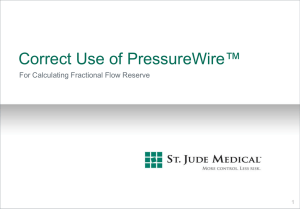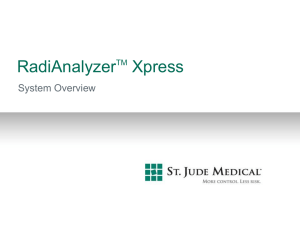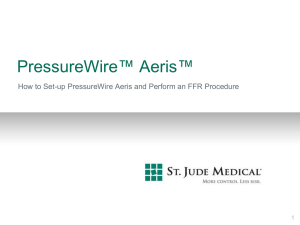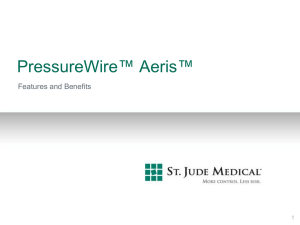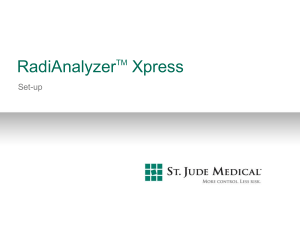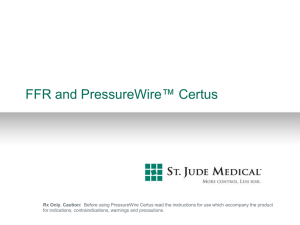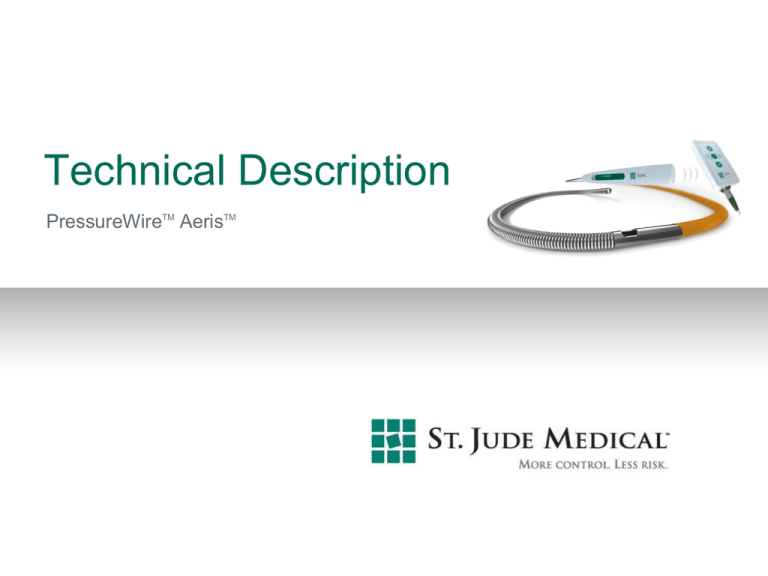
Technical Description
PressureWireTM AerisTM
Technical Specifications
Pressure range
Pressure accuracy
Frequency response
Radio range
Battery time transmitter
Frequency range
Radio type
Radio power
Total signal time delay
-30 to +300 mmHg
±1 mmHg plus ± 1% (<50 mmHg) ± 3% (>50 mmHg)
DC to 25 Hz
2 m*
3 hours
2.4000-2.4835 GHz (ISM band)
Frequency hopping spread spectrum (FHSS)
1 mW peak, 70 μW average
<10 ms
Hydrophilic coated 0.014” pressure guidewire
*15-20 m in free line of sight
2
Detachable transmitter
PressureWire™ Receiver
PressureWire Aeris
The Guidewire component is identical to PressureWire™ Certus™
Hydrophilic coating for low friction, increased device compatibility and increased
overall maneuverability
Strengthened core wire provides excellent torque response and intermediate support
Proximal male connector is hydrophobic which repels moisture and ensures high
reliability and good signal quality even after several reconnections*
3
PressureWire Aeris Transmitter
Battery-operated, disposable (contaminated material)
Communicates via radio with PressureWire Aeris
Automatically zeroes pressure when turned on
Do not turn off the transmitter while inside body, as this would require
removal from the body and re-zeroed
Normal battery operating time 3 hours
Turn cap counter-clockwise 90° to remove guidewire
Transmitter
4
PressureWire Aeris Transmitter - Light Indicators
Light Indicator
5
Cause
Green steady light
Transmitter on
Green pulsating light
Normal operation
Pulsation proportional to blood pressure
Yellow steady light
PressureWire disconnected from
transmitter. Re-insert PressureWire firmly
into transmitter
Green pulsating light &
yellow slow blinking
light
Battery level low:
o Finish procedure or exchange
PressureWire Aeris
Yellow fast blinking
light
Error: Possible cause
oCalibration error
o Battery level too low for operation
o Internal error
Attempt restart by removing PressureWire
from body and turn the transmitter off and
on again
No light
oNot turned on
oBattery dead
PressureWire Aeris Receiver
Radio receiver for pressure from PressureWire Aeris
Connects directly to a free pressure port in the hemodynamic recording system
PressureWire Receiver is mounted permanently on the horizontal cath lab table rail or
on a vertical instrument pole
Pressure and FFR measurement is displayed on existing screens of recording system in
control room and in cath lab
PressureWire Receiver is powered by the recording system front end and requires no
extra connection or battery
PressureWire Receiver
Recording system front end
PressureWire Aeris
P2
P1
AO-transducer
6
Hemodynamic recording system
PressureWire Aeris Receiver
“Plus” button
• Increase pressure offset by +1 mmHg or
increase reference level output in Refout mode
“Connect” button
• Press once to connect to PressureWire Aeris
• Press and hold >3 s to enter Refout mode
• In Refout mode, press once to exit
“Minus” button
• Decrease pressure offset by -1 mmHg or
decrease reference level output in Refout mode
7
PressureWire Aeris Receiver - Light Indicators
Light Indicators
+
-
+
-
Yellow
steady light
At startup: Unit power on and self test passed
During measurement: Wire disconnected from
transmitter or lost connection to PressureWire
Aeris
Green
blinking light
Connect mode – searching for connection
to PressureWire Aeris
Green
steady light
Established connection to PressureWire
Aeris receiving pressure
Incremental
green lights
Reference pressure level output (Refout).
o Press plus/minus to change level: 0-2040-100-200 mmHg
Plus or minus
indicators
steady blue
Positive or Negative pressure offset added
to PressureWire Aeris pressure
Green steady
light & yellow
blinking light
Yellow
blinking light
8
Cause
PressureWire Aeris battery level low
o Finish procedure or exchange
PressureWire Aeris
Internal error
o Attempt restart by disconnecting then
reconnecting PressureWire Receiver from
cath lab recording system
Radio Technology
PressureWire Aeris utilizes advanced radio technology to ensure a stable and secure communication
and avoid disturbing other systems.
1.
2.
3.
4.
5.
PressureWire Transmitter and PressureWire Receiver lock to each other
at calibration using a unique identification code
PressureWire Receiver stores the last connected PressureWire Aeris in its
memory
In the event of power failure PressureWire Receiver resumes
communication
Uses “Frequency Hopping Spread Spectrum” technology (FHSS), to avoid
interference with or disturbance from other systems in the cath lab
Transmits using very low radio power
PressureWire
Receiver
.
.
.
PressureWire Transmitter
400 hops/s
9
79 channels
FAQ – Radio Technology
Will the radio signal be disturbed by mobile phones, computer networks,
X-ray etc?
No. PressureWire Aeris utilizes an advanced radio technology called "frequency
hopping" where the information is sent several times using multiple radio
frequencies.
The system changes radio frequency 400 times per second which means that even
if there are several interfering radio sources, it will locate alternate frequencies.
Extensive, real-life cath lab testing revealed no radio frequency interruption.
10
FAQ – Radio Technology
Can PressureWire Aeris cause disturbances to other cath lab
systems?
PressureWire Aeris is designed to interfere as little as possible with other radio devices
The transmitted radio power is very low - max 1 mW (0.001), average 70 μW (0.000070)
which is 1000 to 10.000 times lower than the power from a normal cellular phone
The frequency hopping technique further reduces the risk by transmitting on each
frequency for only a very short time
The system is completely in-active until a PressureWire Aeris is being used.
The lead enclosure in cath labs also reduces the amount of radio power emitted from
the lab.
PressureWire Aeris has passed all radio acceptance tests by US FCC and EU R&TTE.
11
FAQ – Radio Technology
Can several PressureWire Aeris systems be used at the same time in
the same environment?
Yes. At the start of a procedure PressureWire Aeris locks to its Receiver using a built
in unique identifier code
The PressureWire Receiver can only receive pressure from one connected wire
regardless of any other PressureWire Aeris Systems used in the same environment
The frequency hopping scheme is random which means that several pairs of wires and
receivers can communicate in the same environment without disturbing each other
12
FAQ – Batteries
Can the transmitter - including batteries - be disposed of using
regular hospital protocol for contaminated waste,with the batteries?
Yes. The batteries have very low mercury levels, and since the transmitter is contaminated
by blood, the transmitter with batteries should be disposed of following standard hospital
protocol for contaminated waste.
13
Rx Only
Product referenced is approved for CE Mark
Prior to using these devices, please review the Instructions for Use for a complete listing of
indications, contraindications, warnings, precautions, potential adverse events, and
directions for use.
PressureWire is designed, developed and manufactured by Radi Medical Systems AB.
Patent Pending. Unless otherwise noted, ™ indicates a registered or unregistered
trademark or service mark owned by, or licensed to, St. Jude Medical, Inc. or one of its
subsidiaries. PressureWire, RADI, ST. JUDE MEDICAL, the nine-squares symbol, and
MORE CONTROL. LESS RISK. are registered and unregistered trademarks and service
marks of St. Jude Medical, Inc. and its related companies.
©2010 St. Jude Medical, Inc. All rights reserved.
14

